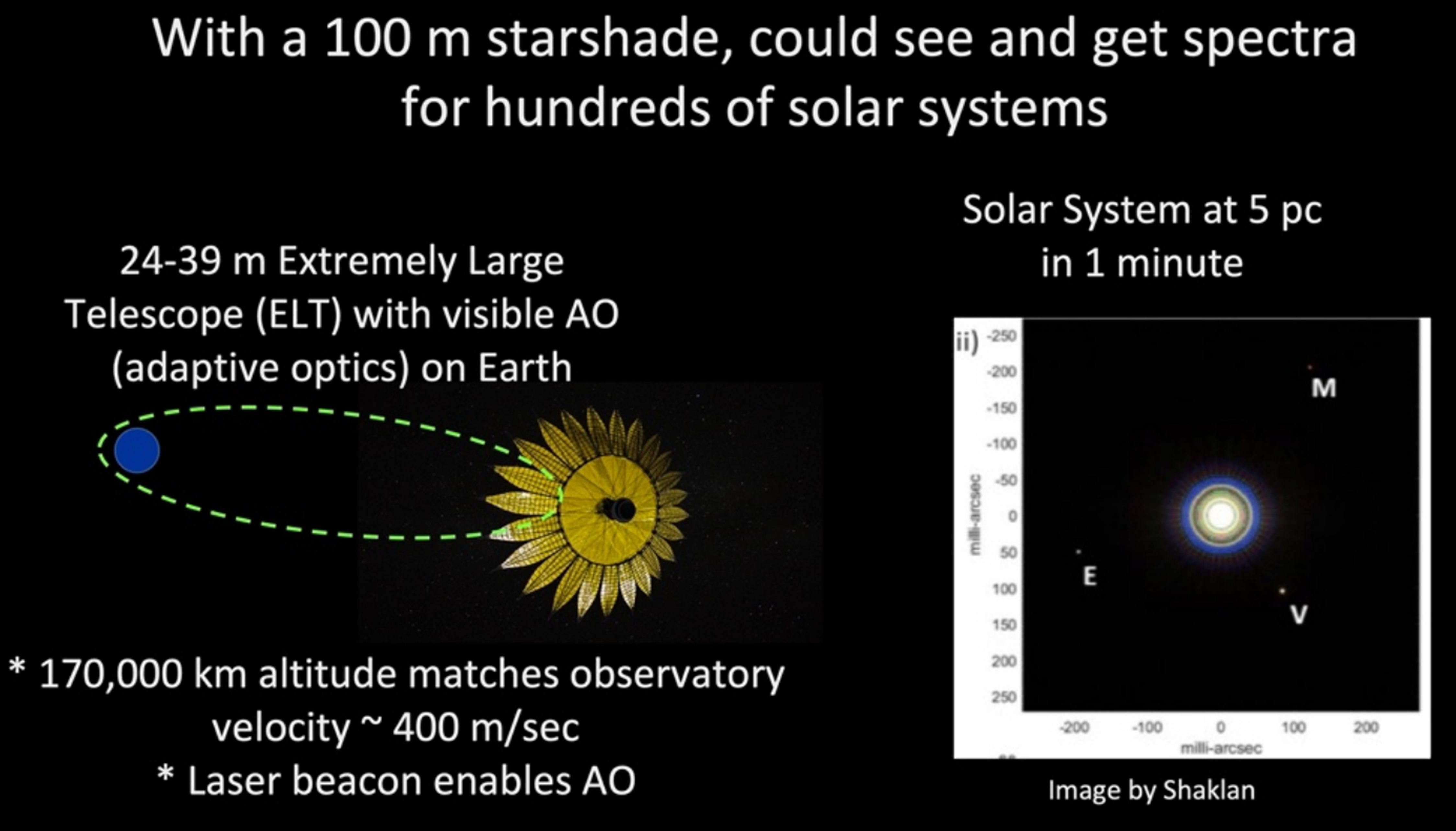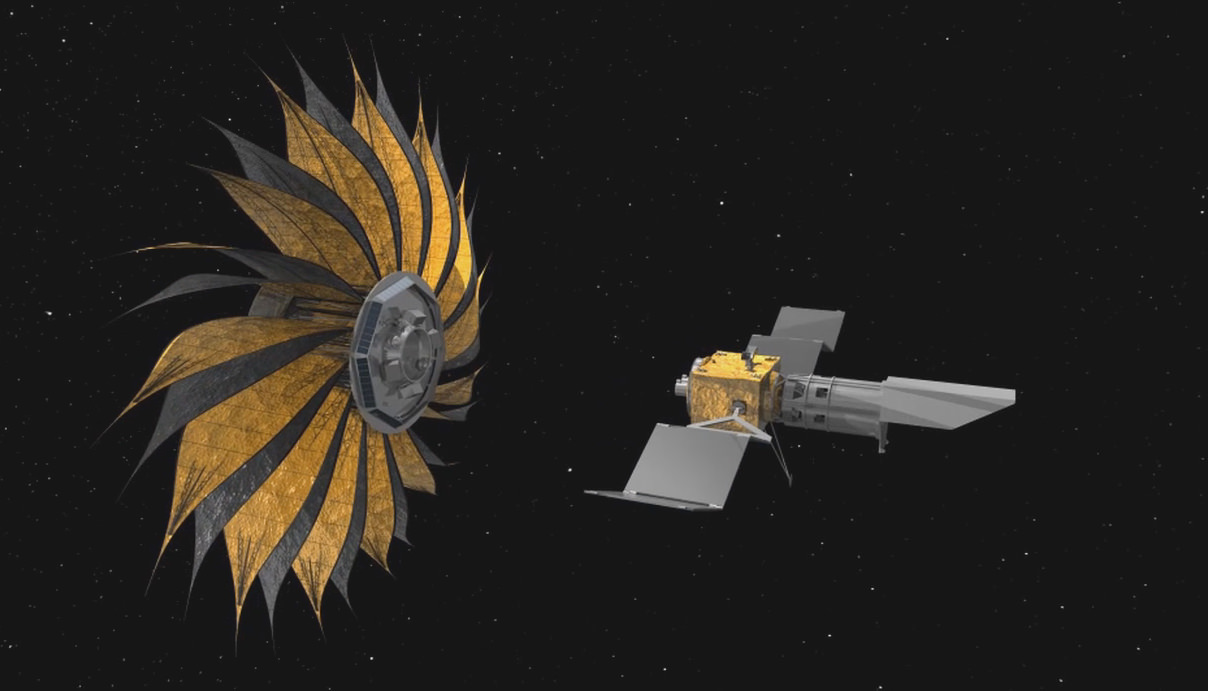The field of exoplanet study has come a long way in recent decades. To date, 5,063 exoplanets have been confirmed in 3,794 systems beyond our own, with another 8,819 candidates awaiting confirmation. In the coming years, tens of thousands of more planets are expected to be found, thanks to next-generation observatories. The ultimate goal in this search is to find planets that are “Earth-like,” meaning they have a good chance of supporting life. This is no easy task, as rocky planets located within their parent star’s habitable zones (HZs) tend to orbit closely, making them harder to see.
To make this process easier, NASA is designing a hybrid observatory consisting of a “Starshade” that will block out a star’s light so that a ground-based telescope can directly image planets orbiting it. The concept is known as the Hybrid Observatory for Earth-like Exoplanets (HOEE), and NASA is looking for public input to make it a reality. To that end, they have launched the Ultralight Starshade Structural Design Challenge, where participants are asked to develop a design for a lightweight starshade structure that could be used as part of the HOEE concept.
The challenge is being hosted by GrabCAD, a Massachusetts-based startup that hosts a free cloud-based platform that helps engineering teams collaborate and manage, view, and share Computer-Aided Design (CAD) files. The NASA Tournament Lab is managing the challenge, which supports the NASA Innovative Advanced Concepts (NIAC) study of the HOEE concept. The challenge is part of NASA’s Prizes, Challenges, and Crowdsourcing program, overseen by NASA’s Space Technology Mission Directorate (STMD).
To date, most known exoplanets have been confirmed through indirect methods. These include the Transit Method (aka. Transit Photometry), where periodic dips in a star’s brightness are used to detect the presence of one or more planets passing in front of it (transiting) relative to the observer. Another is the Radial Velocity Method (aka. Doppler Spectroscopy), where the movement of a star back and forth (relative to the observer) is used to determine the gravitational influences acting on the star (i.e., a system of planets).
When used in combination, these methods are very effective at constraining the size and orbital period of exoplanets (Transit Method) and their respective masses (Radial Velocity Method). However, with next-generation instruments like the James Webb Space Telescope (JWST), astronomers can conduct Direct Imaging studies of exoplanets. In this case, light from distant exoplanets is captured directly and analyzed with a spectrometer. The spectra obtained can yield data on a planet’s surface minerals and determine the presence of oceans, continents, weather systems, vegetation, and the gases that make up its atmosphere.
This data will allow astronomers and astrobiologists to characterize exoplanets and confidently say whether a planet is “habitable” or not. An important part of this method is the coronagraph, an instrument that blocks out the glare of parent stars so that the light reflected from exoplanet atmospheres can be visualized and scanned using spectrometers to determine the chemical composition. Said Dr. John Mather, a senior astrophysicist at NASA’s Goddard Space Flight Center and a senior project scientist for the JWST:
“The hybrid observatory might help us answer some of the most pressing questions about extraterrestrial life. Observing many systems would help answer the question of why configurations like our own are rare and why none is quite like home. It is truly exciting that the public can be part of this revolutionary effort. I can’t wait to see what ideas they bring to the table.”

The key to the HOEE is the “Starshade” spacecraft, a concept introduced by the Habitable Exoplanet Observatory (HabEx) at NASA JPL back in 2016. Initially, it was thought that only space telescopes like the James Webb and the Nancy Grace Roman Space Telescope (RST) could benefit from a starshade-type spacecraft. But with the HOEE concept, ground-based telescopes that fall into the 30-meter-class (~100 ft) range could also conduct Direct Imaging surveys. This includes next-generation observatories like the Extremely Large Telescope (ELT), Giant Magellan Telescope (GMT), and the Thirty Meter Telescope (TMT).
For the Ultralight Starshade Structural Design Challenge, NASA is looking for ideas for a lightweight starshade that could accomplish that very task. According to NASA, the goal of this challenge is to develop an “innovative low-mass starshade structure that could meet the mass, shape, strength, and stiffness requirements.” Participants are free to choose from four suggested designs (or a hybrid thereof), which include:
1. Ultralight version of the current JPL HabEx concept
2. Umbrella with petals
3. Rigidizable inflated structure
4. Truss-based structures
The ideal design, they state, will allow for compact packaging and successful deployment once in Earth’s orbit. In other words, it must be able to collapse and fold up so the spacecraft can fit inside a rocket payload fairing, then unfurl once it reaches space. This is similar to what engineers accomplished with James Webb, especially where its primary mirror and sunshield were concerned. They also stress that it must have the lowest possible mass to be easier (and cheaper) to launch, that its chemical thrusters can keep it aligned during observations, and change its orbit to observe different targets.
These and other details (including orbital distance and the starshade’s diameter) are specified on the challenge page:
“An orbiting starshade (170,000 km away) could cast a shadow of the central star without blocking the reflected light from its planets. So that it can be used with the largest ground-based telescopes, the starshade needs to be 100 m in diameter. This large structure must be tightly packaged so that it can fit inside the fairing of a large rocket (e.g., Falcon Heavy or Starship).
“It must also have the lowest possible mass so that chemical thrusters can keep it aligned during observations and solar electric propulsion system can change its orbit to observe many targets. NASA seeks breakthrough mechanical/structural concepts for a deployable, low mass, high stability, and high stiffness starshade structure.”
In order to be eligible for this challenge, participants must either be U.S. citizens or from an eligible country (specified here). The top five submissions will share a prize purse of $7,000. The full list of the competition requirements and all relevant information and documentation are posted on the GrabCAD challenge page.
Further Reading: NASA

